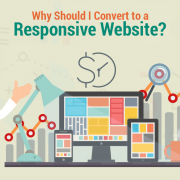Best practices for an effective WordPress website development
One of the most popular CMS and website builders of all time, WordPress accounts for 26 percent of all sites on the web. To improve a website’s visibility, impact, functionality, and mobile readiness, businesses can follow certain best practices while building a new WordPress site. Graphic Lux shares some researched tips for website development on WordPress.
1. Choose a Simple, Compelling Color Palette
Incorporating brand colors into the website design and theme is imperative. A great color palette sets the tone for the visitors, gives more impact to the website, and highlights the most important parts of the business online.
Too many colors on a website are discouraged. Instead, use a limited color palette that has two main colors such as black or dark gray on white background for readable text with call-out sections with a dark accent background and light text.
2. Uncluttered Clean White Space Design
A great website design uses white space intelligently. Too much information in a small amount of space makes it visually crowded making it unreadable. Whereas too much white space can make a design seem disorganized.
Designers must highlight the most important images, videos, and headlines with white space. Call-to-action buttons must also be highlighted by the white space around them.
3. Custom Fonts and Typography
Using readable sans serif fonts like Helvetica is great but custom typography can help a brand’s voice substantially. On WordPress, there are a variety of font plugins that allow a selection of custom fonts that suit a brand.
Before choosing any font, it is important to consider its readability on desktop and mobile, as well as how it looks when customized when using italics or bold. The font must also stand out on a colored background or image.
4. Get Higher Quality Images
The latest and the highest quality photos that resonate with the brand’s tone must be chosen for the website. Stock images that have been around on the internet too long must be avoided.
Photos with unique people and settings that complement the content and communicate the brand image accurately with just a glance are ideal. If the organization has its own visually interesting and quality images, it will elevate the quality of the site by leaps and bounds.
5. Check the Readable Permalinks
A permalink is the web address used to link to the content. The URL to each post should be permanent and never change — hence the name permalink. Permalinks are set up under “Settings” in the WordPress dashboard. The standard WordPress URL format is yourdomain.com/p=123 should be changed to “post name” so that it appears as yourdomain.com/your-post-name. This assists with SEO and link structures.
A custom permalink strategy can be defined by a professional website design service such as Graphic Lux to help customize this important feature.
6. Pick the Right Plugins
Most WordPress themes come with many plugins that can drag down a site’s loading time and mobile experience besides interfering with one another and causing errors.
Most of the plugins are essential to build the website and organize different elements while others are for security, SEO, image optimization, and navigation. Any redundant plugins must be uninstalled and all relevant plugins must be constantly researched and updated. This constant tussle with plugins can sometimes be overwhelming.
Businesses can take support from WordPress website design specialists such as Graphic Lux to manage the complete process smoothly.
7. Conduct User Experience Tests
Regularly monitor for the friction points that hamper the customer’s journey on the WordPress site. Every website has a navigational path. For example, customers are unlikely to fill in a form on mobile that requires multiple entries and takes forever to fill in unless they get something of immediate value to them in return.
Navigate to the website from desktop and mobile separately to identify the flaws such as page and image loading time, CTA button activity, and transaction or sign-up time for something. A user-friendly process is crucial for website efficacy.
Moreover, all the important content such as CTA and product must feature “above the fold”.
8. Smooth, Mobile-Friendly Navigation
A traditional navigation menu across the top includes links to “About Us,” “Products,” “Contact,” and more. Sometimes, there are sub-navigation menus that break out when the cursor hovers over each link. Although simple and clean navigation is ideal some businesses need a lot of navigational content. The best practice is to have structured and easily visible navigational content on desktop and mobile. The navigational menu should send the client in the right direction, it should load quickly and must work efficiently on mobile.
9. Update the Site in Test Environments First
The security of a website is crucial and can be maintained by regular updates. WordPress offers security updates every month, but an incompatible plugin can make things insecure. The best practice is to update WordPress in a secure test environment and then check the site’s functionality before updating the live site. This ensures that if anything goes wrong, it is under control.
10. Become familiar with the Gutenberg Editor
Gutenberg, alternatively known as the “WordPress block editor” is the WordPress content editor introduced in WordPress 5.0, released on December 6, 2018. It has some special features for formatting and content blocks. With Gutenberg, every element in the content is a block, which allows for easy manipulation of content. Each paragraph is a block, each image is a block, each button is a block with its own formatting options, styles, and design options.
Businesses that are looking to improve their WordPress website or planning on creating new websites can reach out to the WordPress website design specialists at Graphic Lux for a smooth and effective website building experience.
Why Graphic Lux?
Graphic Lux offers an array of digital services to clients across Buffalo, NY. It is a one-stop-shop for a business’ digital needs:
- WordPress Website design, consultation, maintenance, and SEO: Graphic Lux specializes in WordPress website design and has over 12 years of experience. It can help build a WordPress custom theme from scratch or take a pre-existing theme and customize it as per client needs. The team also keeps the site running smoothly, without any downtime.
- Hosting: The team offers the assurance that a website will be online and available for customers and visitors with all its data intact.
- Brand building: The team can help create a strong brand identity for the client by optimizing the content using visual devices.
- Dedicated support: With years of experience and unrivaled expertise the Graphic Lux support team will understand the client’s concerns and goals to give them peace of mind.
- Responsive web design: Graphic Lux is on the cutting edge of designing and delivering responsive web and mobile apps. Its solutions decrease time to market and reduce maintenance costs.
For more information, email [email protected] or call at (716) 712-4589.
Contact Information:Graphic Lux
1 W Seneca St Suite 29-M18
Buffalo, NY 14203
United States
Matthew Lux
(716) 712-4589
https://graphiclux.com



















